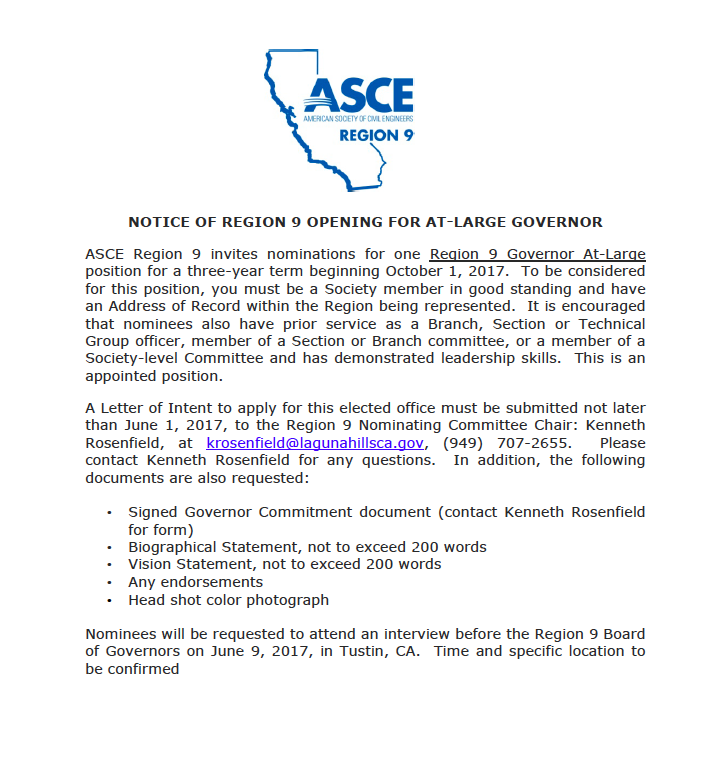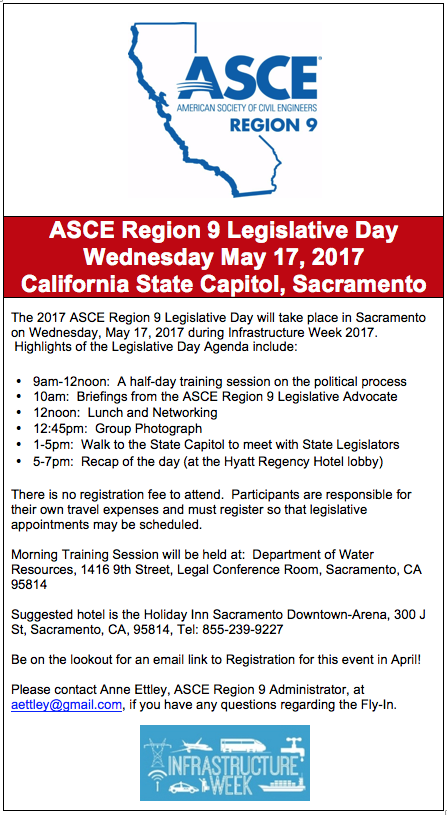March 2017 – Region 9 Reports
REGION 9 REPORTS – MARCH 2017 NEWSLETTER
Hot Topics in Transportation Engineering in California
by David M. Schwegel, P.E.,
Region 9 Transportation Committee Chair

The ASCE Region 9 Transportation Committee has been collaborating with agencies and consultants statewide in connection with organizing the 2017 California Infrastructure Symposium & Region 9 Awards Dinner event to be held on March 31 at the California Science Center in Los Angeles, www.cais17.org. Based on this collaboration, the following 10 hot topics were identified and will be highlighted at the event:
- Autonomous Vehicles: These vehicles are able to perceive their surroundings and navigate without human aid.
- Connected Vehicles: This refers to the Intelligent Transportation System (ITS) infrastructure enabling vehicle-to-vehicle communication.
- Driverless Vehicles: Former US Transportation Secretary Anthony Foxx and Google CEO Eric Schmidt drove in such a vehicle between the San Jose International Airport (SJC) and Google Corporate Headquarters for a Town Hall Meeting on Transportation in 2014. Lauren Isaac of WSP/Parsons Brinckerhoff will be presenting on this topic at the Symposium.
- Marketing the Transportation Profession: The “Dream Big” IMAX movie will be shown at the Symposium to promote the Civil Engineering profession. Look for those elements that are specific to Transportation Engineering.
- Public Outreach: As Radio Show Commentator David Ross explained at a Women’s Transportation Seminar (WTS) Gala in Seattle in 2003, “you transportation professionals design the systems that my listeners complain about” underscoring the importance of clearly communicating to the public the challenging tradeoffs we face in our daily decision making.
- Connected Mass Transit Corridors: Providing near-term conventional rail improvements to transport passengers to the Initial Operating Section (IOS) (Central Valley to Silicon Valley) of the High-Speed Rail Project (hsr.ca.gov) are essential for generating the ridership revenue necessary to construct High-Speed Rail over the Tehachapi Mountains into the Los Angeles Basin. Metrolink CEO Art Leahy will discuss the latest efforts on Southern California’s premier commuter rail system to get the region ready to connect to High-Speed Rail (www.hsr.ca.gov).
- Rail/Airport Integration: Bringing rail to airports allows airline passengers to access city centers without having to fight traffic congestion. Jacob Adams of the Los Angeles World Airports will provide an update on the latest efforts to run Metro Light Rail to Los Angeles International Airport (LAX).
- Fixing Our Roads: Greater Sacramento Area Economic Council (https://www.selectsacramento.com) CEO Barry Broome explained at a Fix Our Roads Rally in Sacramento on January 18, that deteriorating roadways communicates to prospective out of town companies that “we can’t even take care of our most basic infrastructure”, making marketing and economic stimulation efforts especially challenging.
- Goods Movement: As California High Speed Rail Authority (hsr.ca.gov) Board Chairman Dan Richard explained at the US High Speed Rail (www.ushsr.com) Conference in San Francisco in May 2012, advances in the Panama Canal continue to put California Ports at a competitive disadvantage primarily due to inland traffic congestion. The Symposium will feature an entire session on Southern California Ports.
- Transportation Funding: Transportation Committee Chair and Assembly Member Jim Frazier will discuss the latest efforts to get the Legislature to pass a long-term Transportation Funding Package. Los Angeles County Metro CEO Phil Washington and Former Los Angeles City Mayor Antonio Villaraigosa will discuss the success of the recent Los Angeles County Half-Cent Sales Tax Measure at the Symposium.
ASCE Members statewide are always encouraged to collaborate with like-minded professionals both within and beyond the Civil Engineering profession. Specifically, members are encouraged to explore these hot topics more deeply at the 2017 California Infrastructure Symposium on March 31 where subject matter experts will be addressing each one in depth.
Connected and Automated Vehicle Definitions
by Greg Larson, Chief, Caltrans Office of Traffic Operations Research
As a follow-up to the articles on Transportation Hot Topics and the research that Caltrans is doing in the areas of Connected, Automated, and Autonomous Vehicles, the Caltrans Office of Traffic Operations research is providing definitions on these three topics:
- Connected Vehicles: Connected vehicles use vehicle-to-vehicle and vehicle-to-infrastructure communications to enable applications that improve the safety and mobility of vehicle travel while reducing adverse environmental impacts. The best examples of these communications technologies are Dedicated Short Range Communications (DSRC), and the existing cellular telephone network. Using a combination of either or both or these technologies, data related to road and traffic conditions can be collected from vehicles as they travel through the transportation system, processed into useful information, and used by operating agencies to more efficiently manage the system and to inform drivers so that they can make better decisions pertaining to their safety and mobility. Drivers are still always in responsible control of the safe operation of their vehicle, but receive enhanced information, alerts, and if necessary, warnings to improve their safety and mobility.
- Automated Vehicles: Automated vehicles use sensors, computers, and actuators to control the steering and speed (throttle and brakes) of the vehicle in a manner that ensures a combination of both safety and mobility. Such vehicles may also be connected (see above) or autonomous (see below). The concept of vehicle automation builds upon emerging driver assistance systems (e.g., Lane Keeping Assist, Cooperative Adaptive Cruise Control, and Automated Emergency Braking Systems), which help drivers perform their driving task better, and envisions a time when machines will be primarily responsible for safely controlling the vehicle operation, perhaps with still some level of driver “attention” under well-defined conditions.
- Autonomous Vehicles: These are automated vehicles that are self-contained, meaning that they gather all the knowledge of the environment around them from their own sensors, and are not dependent upon receiving data from other vehicles or the infrastructure. Many use a priori knowledge of roadway engineering, such as standard lane widths and markings, to enhance their performance. Performance may be degraded if their sensors are occluded from “seeing” objects around them by other nearby vehicles, darkness, bad weather, or fixed objects such as buildings or foliage.
For more information on the Caltrans Division of Traffic Operations, go to http://www.dot.ca.gov/trafficops/.
To learn more about the activities of the Region 9 Transportation & Development Committee, please contact me at davidmschwegel1@gmail.com


